Connect With Us
Blog
Items filtered by date: January 2024
Arthritis Can Cause Pain in the Feet and Ankles
Common Symptoms of Bunions
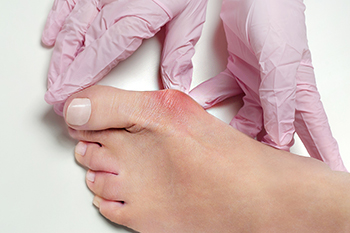
Bunions, a prevalent foot deformity, reveal themselves through an array of recognizable symptoms. One telltale sign is the development of a bony bump at the base of the big toe, often accompanied by redness and swelling. As the tip of the big toe deviates toward the adjacent toes, persistent pain or soreness ensues, particularly when walking or wearing shoes. Corns or calluses may form where the first and second toes overlap, exacerbating discomfort. Limited toe movement and stiffness can impede flexibility. Shoes that once fit comfortably may now cause tightness and discomfort, reflecting the altered shape of the foot. Recognizing these common symptoms is pivotal for timely intervention. By understanding these subtle yet critical signs, individuals can take proactive steps towards managing bunions and nurturing overall foot health. If you have developed a bunion, it is strongly suggested that you are under the care of a podiatrist who can determine what the best relief and treatment is for you.
If you are suffering from bunion pain, contact one of our podiatrists of Foot & Ankle Surgical Group. Our doctors can provide the care you need to keep you pain-free and on your feet.
What Is a Bunion?
Bunions are painful bony bumps that usually develop on the inside of the foot at the joint of the big toe. As the deformity increases over time, it may become painful to walk and wear shoes. Women are more likely to exacerbate existing bunions since they often wear tight, narrow shoes that shift their toes together. Bunion pain can be relieved by wearing wider shoes with enough room for the toes.
Causes
- Genetics – some people inherit feet that are more prone to bunion development
- Inflammatory Conditions - rheumatoid arthritis and polio may cause bunion development
Symptoms
- Redness and inflammation
- Pain and tenderness
- Callus or corns on the bump
- Restricted motion in the big toe
In order to diagnose your bunion, your podiatrist may ask about your medical history, symptoms, and general health. Your doctor might also order an x-ray to take a closer look at your feet. Nonsurgical treatment options include orthotics, padding, icing, changes in footwear, and medication. If nonsurgical treatments don’t alleviate your bunion pain, surgery may be necessary.
If you have any questions, please feel free to contact our office located in Henderson, NV . We offer the newest diagnostic and treatment technologies for all your foot care needs.
Causes of Foot Stress Fractures
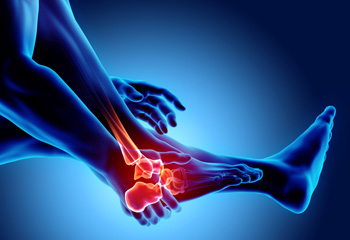
A foot stress fracture, a condition prevalent among athletes and individuals engaged in repetitive weight-bearing activities, is characterized by tiny cracks in the bones of the foot. These fractures often result from overuse, with excessive and repetitive impact on the feet causing structural fatigue. Contributing causes include sudden increases in physical activity, improper footwear, or inadequate training surfaces. Symptoms manifest gradually, beginning with localized pain during activity that subsides with rest. As the stress fracture progresses, the pain becomes persistent, and swelling may occur. Tenderness to touch, particularly at specific points on the foot, is a common indicator. Ignoring these symptoms can lead to more severe fractures, potentially requiring prolonged recovery. Understanding the definition, causes, and symptoms of foot stress fractures is essential for individuals engaged in high-impact activities. If you have a foot stress fracture, it is suggested that you make an appointment with a podiatrist who can guide you toward the best treatment.
Stress fractures occur when there is a tiny crack within a bone. To learn more, contact one of our podiatrists from Foot & Ankle Surgical Group. Our doctors can provide the care you need to keep you pain free and on your feet.
How Are They Caused?
Stress fractures are the result of repetitive force being placed on the bone. Since the lower leg and feet often carry most of the body’s weight, stress fractures are likely to occur in these areas. If you rush into a new exercise, you are more likely to develop a stress fracture since you are starting too much, too soon. Pain resulting from stress fractures may go unnoticed at first, however it may start to worsen over time.
Risk Factors
- Gender – They are more commonly found in women compared to men.
- Foot Problems – People with unusual arches in their feet are more likely to develop stress fractures.
- Certain Sports – Dancers, gymnasts, tennis players, runners, and basketball players are more likely to develop stress fractures.
- Lack of Nutrients – A lack of vitamin D and calcium may weaken the bones and make you more prone to stress fractures
- Weak Bones – Osteoporosis can weaken the bones therefore resulting in stress fractures
Stress fractures do not always heal properly, so it is important that you seek help from a podiatrist if you suspect you may have one. Ignoring your stress fracture may cause it to worsen, and you may develop chronic pain as well as additional fractures.
If you have any questions, please feel free to contact our office located in Henderson, NV . We offer the newest diagnostic and treatment technologies for all your foot care needs.
Common Foot Problems
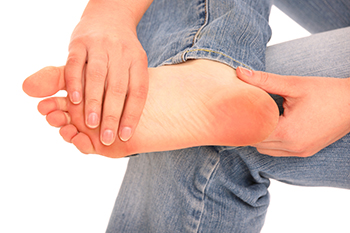
Our feet bear the weight of our bodies and help us to move about. However, they are also susceptible to a range of common problems that can be quite uncomfortable. One prevalent issue is bunions, which occur when the big toe joint becomes misaligned and causes a painful bump. Another common ailment is plantar fasciitis, characterized by sharp heel pain due to inflammation of the tissue that supports the arch of the foot. Ingrown toenails can be particularly bothersome, causing pain and potential infection. Athlete's foot is a fungal infection that leads to itching and peeling skin on the feet. Corns and calluses are also frequent, resulting from friction and pressure on the skin. To keep your feet in top shape, it is essential to be mindful of these common problems. If you have any type of foot pain, it is suggested that you are under the care of a podiatrist who can offer the correct treatment for your problem.
Foot Pain
Foot pain can be extremely painful and debilitating. If you have a foot pain, consult with one of our podiatrists from Foot & Ankle Surgical Group. Our doctors will assess your condition and provide you with quality foot and ankle treatment.
Causes
Foot pain is a very broad condition that could be caused by one or more ailments. The most common include:
- Bunions
- Hammertoes
- Plantar Fasciitis
- Bone Spurs
- Corns
- Tarsal Tunnel Syndrome
- Ingrown Toenails
- Arthritis (such as Gout, Rheumatoid, and Osteoarthritis)
- Flat Feet
- Injury (from stress fractures, broken toe, foot, ankle, Achilles tendon ruptures, and sprains)
- And more
Diagnosis
To figure out the cause of foot pain, podiatrists utilize several different methods. This can range from simple visual inspections and sensation tests to X-rays and MRI scans. Prior medical history, family medical history, and any recent physical traumatic events will all be taken into consideration for a proper diagnosis.
Treatment
Treatment depends upon the cause of the foot pain. Whether it is resting, staying off the foot, or having surgery; podiatrists have a number of treatment options available for foot pain.
If you have any questions, please feel free to contact our office located in Henderson, NV . We offer the newest diagnostic and treatment technologies for all your foot care needs.
Peripheral Neuropathy and Its Impact on Feet
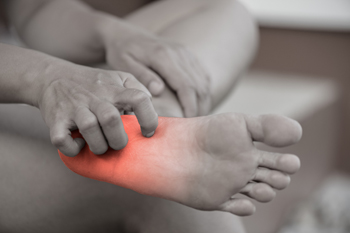
Peripheral neuropathy, a condition stemming from nerve damage in the peripheral nervous system, manifests as a range of symptoms that can significantly impact the feet. The peripheral nerves, responsible for transmitting signals between the body and the brain, may become compromised, leading to sensations like tingling, numbness, or foot pain. This condition often arises from various underlying causes, including diabetes, certain medications, or even infections. The feet, being distant from the central nervous system, are particularly vulnerable to peripheral neuropathy. The impaired nerve function can affect balance and coordination, increasing the risk of injuries. Moreover, individuals with peripheral neuropathy may experience difficulty in detecting temperature or pressure changes, raising concerns about foot health. If you have symptoms of peripheral neuropathy, it is suggested that you are under the care of a podiatrist who can help you manage this condition.
Neuropathy
Neuropathy can be a potentially serious condition, especially if it is left undiagnosed. If you have any concerns that you may be experiencing nerve loss in your feet, consult with one of our podiatrists from Foot & Ankle Surgical Group. Our doctors will assess your condition and provide you with quality foot and ankle treatment for neuropathy.
What Is Neuropathy?
Neuropathy is a condition that leads to damage to the nerves in the body. Peripheral neuropathy, or neuropathy that affects your peripheral nervous system, usually occurs in the feet. Neuropathy can be triggered by a number of different causes. Such causes include diabetes, infections, cancers, disorders, and toxic substances.
Symptoms of Neuropathy Include:
- Numbness
- Sensation loss
- Prickling and tingling sensations
- Throbbing, freezing, burning pains
- Muscle weakness
Those with diabetes are at serious risk due to being unable to feel an ulcer on their feet. Diabetics usually also suffer from poor blood circulation. This can lead to the wound not healing, infections occurring, and the limb may have to be amputated.
Treatment
To treat neuropathy in the foot, podiatrists will first diagnose the cause of the neuropathy. Figuring out the underlying cause of the neuropathy will allow the podiatrist to prescribe the best treatment, whether it be caused by diabetes, toxic substance exposure, infection, etc. If the nerve has not died, then it’s possible that sensation may be able to return to the foot.
Pain medication may be issued for pain. Electrical nerve stimulation can be used to stimulate nerves. If the neuropathy is caused from pressure on the nerves, then surgery may be necessary.
If you have any questions, please feel free to contact our office located in Henderson, NV . We offer the newest diagnostic and treatment technologies for all your foot care needs.
Using the Brannock Device for Proper Shoe Fitting
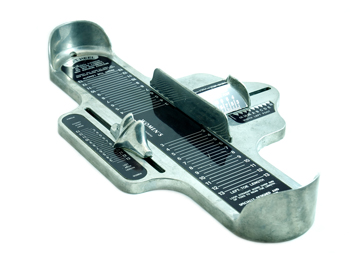
Fitting shoes properly is an important aspect of foot health and overall comfort. The Brannock device, a ubiquitous foot-measuring tool found in shoe stores, is a valuable tool for ensuring the right fit. Using the Brannock device is a straightforward process. Start by removing your current footwear and placing one foot onto the device's base, ensuring your heel is snug against the heel cup. Then, adjust the slider to reach the tip of your longest toe, typically the big toe. The device provides three key measurements, which are the heel-to-toe length, arch length, and width. Pay attention to all three as they contribute to a well-fitted shoe. The Brannock device takes the guesswork out of shoe sizing, enabling you to find the ideal fit. Remember that feet can vary in size, and it is essential to measure both feet. When trying on shoes, use the larger foot's measurements as a guide for the best overall fit. Properly fitted shoes can prevent discomfort, reduce the risk of foot problems, and provide a foundation for healthy, happy feet. A podiatrist can assist you in how to use the Brannock device to obtain your proper shoe size, and it is suggested that you confer with this type of doctor for any questions you may have.
Finding a properly-fitting shoe is important in reducing injuries and preventing foot problems. For more information about treatment, contact one of our podiatrists from Foot & Ankle Surgical Group. Our doctors will treat your foot and ankle needs.
Proper Shoe Fitting
A common concern when it comes to foot health, having properly fitted shoes can help prevent injuries to the foot. Out feet affect our posture and gait, which in turn affects the biomechanics and overall bodily structure. With 33 joints, 26 bones, and over 100 ligaments, the potential for serious injury is much greater than one realizes. Although the feet cease growth in adulthood, they still change shape as they mature. Here are some factors to consider when it comes to investing in proper fitting shoes:
- Be sure the shoes fit correctly right away
- Ensure the ball of your foot fits comfortably in the widest portion of the shoes
- Even though they may look fashionable, improper fitting shoes can either create adverse conditions or exacerbate existing ones you may already have
- Walk along a carpeted surface to ensure the shoes comfortably fit during normal activity
Keeping in mind how shoes fit the biomechanics of your body, properly-fitting shoes are vitally important. Fortunately, it is not difficult to acquire footwear that fits correctly. Be sure to wear shoes that support the overall structure of your body. Do your feet a favor and invest in several pairs of well-fitted shoes today.
If you have any questions please feel free to contact our office located in Henderson, NV . We offer the newest diagnostic and treatment technologies for all your foot and ankle needs.

